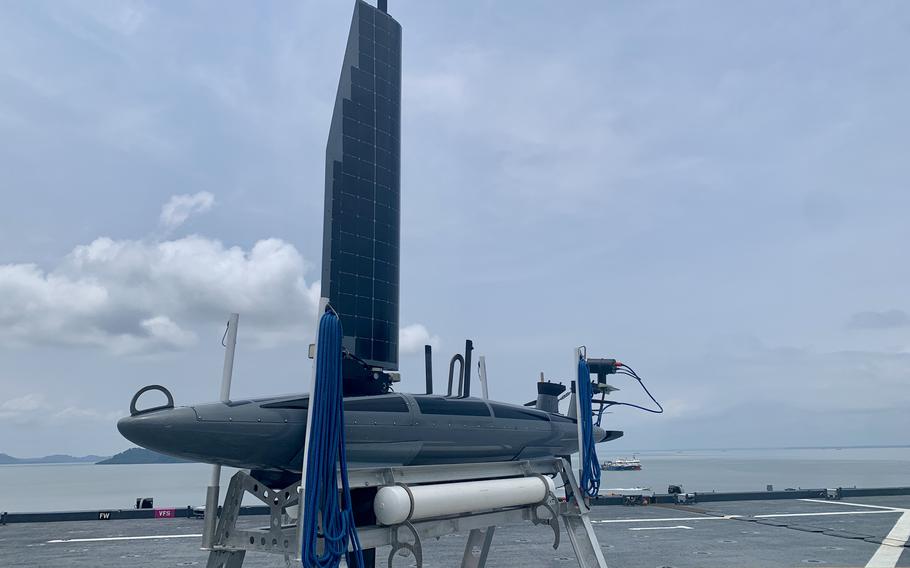
The TRITON drone, manufactured by Gulfport, Miss.-based Ocean Aero, is capable of operating on the surface or underwater. The Navy is testing the drone's capabilities in the Gulf of Guinea during the Obangame Express exercise, which started on May 6, 2024 in Libreville, Gabon. (Alison Bath/Stars and Stripes)
LIBREVILLE, Gabon — The U.S. Navy is testing an autonomous drone that can operate above and below the surface in a bid to help African countries battling piracy, the illicit drug trade and other illegal activities in the Gulf of Guinea.
The TRITON drone’s introduction during the Obangame Express multinational exercise is designed to determine whether it’s suitable for long-term, sustained use in the region, Rear Adm. Michael Mattis, director of Strategic Effects, U.S. Naval Forces Europe-Africa, said Tuesday.
The two-week exercise comes as the U.S. focuses on the partners in West Africa that it’s still legally able to work with, especially following a recent coup in Niger, where the U.S. was forced to abandon a $110 million aerial drone base. Russia and China have made their own inroads in the region.
The exercise, which ends May 17, includes launching and recovering the drone from the expeditionary sea base USS Hershel “Woody” Williams, and conducting vessel boarding, searches and seizures, Mattis said.
Those activities will help determine if TRITON can be used reliably in a region where it isn’t easy for the Navy to quickly source supplies and repairs. The testing also will show whether the drone is a good fit for countries like Gabon, Ghana and Cameroon, which have smaller navies and limited resources, Mattis added.
“The idea is that we have long periods of operations, (and) that we push these vehicles to their limits of endurance and sustainability, and we understand where those things are,” he said.
The 775-pound, 14½ foot-long TRITON surface drone is manufactured by Gulfport, Miss.-based Ocean Aero. The similarly named MQ-4C Triton aerial drone is made by Northrop Grumman.
The Navy is expanding its use of aerial, surface and underwater drones, which are seen as vital for deterrence and use in future conflicts.
For example, U.S. Naval Forces Central Command/U.S. 5th Fleet operates a fleet of drones, including the TRITON, in the Persian Gulf.
Recently, an MQ-4C Triton aerial drone was deployed to U.S. Naval Air Station Sigonella to work with P-8 Poseidon patrol aircraft in the U.S. Naval Forces Europe area of responsibility.
Drones also allow the service to stretch its reach in regions that are understaffed or seldom visited.
Three Aerosonde aerial drones on Woody Williams are used for intelligence gathering and security. The aircraft, which fly daily, also are available to West African countries to help monitor territorial waters, according to its Providence, R.I.-based manufacturer.
The opening days of the Obangame exercise already have taught the Navy about TRITON’s performance.
During shipment to West Africa, one of the two being used developed a small crack in its hull. That gave the Navy an opportunity to see the manufacturer quickly fix and redeploy it with minimal disruption, Mattis said.
Meanwhile, initial testing in an estuary revealed limited use. The tidal flow of the estuary matched the drone’s maximum surface speed of about 6 mph, causing it to drain its batteries.
Mattis sees those problems as valuable lessons.
“We’re trying to get something in the water and learn,” he said. “We want to understand where the challenges of these vessels exist so we can tailor our operations appropriately to them.”
One of TRITON’s more unusual features is its ability to submerge to avoid detection or a collision with another vessel, said Samuel Buras, a field applications engineer for Ocean Aero aboard the Woody Williams on Tuesday.
The drone is propelled while underwater by three thrusters. It can loiter in an area for as many as eight days or be on a mission for up to five, he said.
On the surface, it can operate for two weeks or longer. It can be used for mine countermeasures, anti-submarine warfare and subsurface seabed warfare, among other missions, according to Ocean Aero’s website.
After Obangame ends, the drones will stay aboard the Woody Williams. They’ll be used during an upcoming U.S. Army exercise in Morocco and may be used at an exercise in Portugal in the fall, Mattis said.
Introduction of the drone continues significant Navy investment in the Gulf of Guinea region. Those efforts include the construction of maritime operational centers and coastal radar systems, and introduction of a web-based program that allows countries to share unclassified information.
The service also has donated surface vessels to African countries, including two former U.S. Coast Guard cutters commissioned into Ghana’s navy in September.
“What we are trying to do is equip our partner navies and our partner nations with the tools to handle” the problems they face, Mattis said.